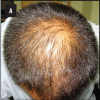Androgenetic Alopecia Treatment in Asian Men
- PMID: 30057663
- PMCID: PMC6057731
Androgenetic Alopecia Treatment in Asian Men
Abstract
Background: Androgenetic alopecia (AGA) is a common form of hair loss in Asian men. Although AGA is often regarded as a relatively minor dermatological condition, hair loss can impact self-image and is a main cause for anxiety and depression in some men. We have treated patients with AGA for seven years. Objective: The goal of this study was to evaluate the effectiveness of our combination therapy in Asian men with AGA. Participants: Between the years 2011 and 2017, 18,918 male patients were treated in our center. Our combination therapy consists of oral finasteride once daily, oral and topical minoxidil twice daily, and an injectable treatment of lidocaine and an AGA treatment solution comprising minoxidil, arginine, aspartic acid, caffeine, copper tripeptide, lysine, niacin, panthenol, propanediol, propylen glycol, retinyl palmitate, pyridoxine, sodium hyaluronate, and ubiquinone once monthly for more than six months. Measurements: Digital photographs were taken pre- and post-treatment, and patient assessments were recorded after six and 12 months post-treatment. Results: Significant improvement was observed in all patients in the digital photographs. Ninety-six and 80 percent of the patients reported satisfaction with the results of the treatment after six and 12 months post-treatment. Minor complications were observed in 802 (4.2%) patients, characterized by slight pain and bleeding due to injection, swelling, dizziness, itching, and erythema of the scalp. Slight pain was reported in 651 patients (3.4%), and slight bleeding was reported in 56 patients (0.3%). Sexual dysfunctions were uncommon. These minor complications resolved spontaneously. No treatment-related adverse events were observed. Conclusion: A combination of these therapeutic options offers safe and highly efficacious treatment for AGA with minimal complications.
Keywords: Androgenetic alopecia (AGA); Combination therapy; Finasteride; Hair loss; Minoxidil.
Conflict of interest statement
FUNDING:No funding was provided. DISCLOSURES:The authors have no conflicts of interest relevant to the content of this article.
Figures









References
-
- Yang CC, Hsieh FN, Lin LY, et al. Higher body mass index is associated with greater severity of alopecia in men with male-pattern androgenetic alopecia in Taiwan: a cross-sectional study. J Am Acad Dermatol. 2014;70:297–302.e1. - PubMed
LinkOut - more resources
Full Text Sources
Other Literature Sources
Miscellaneous
